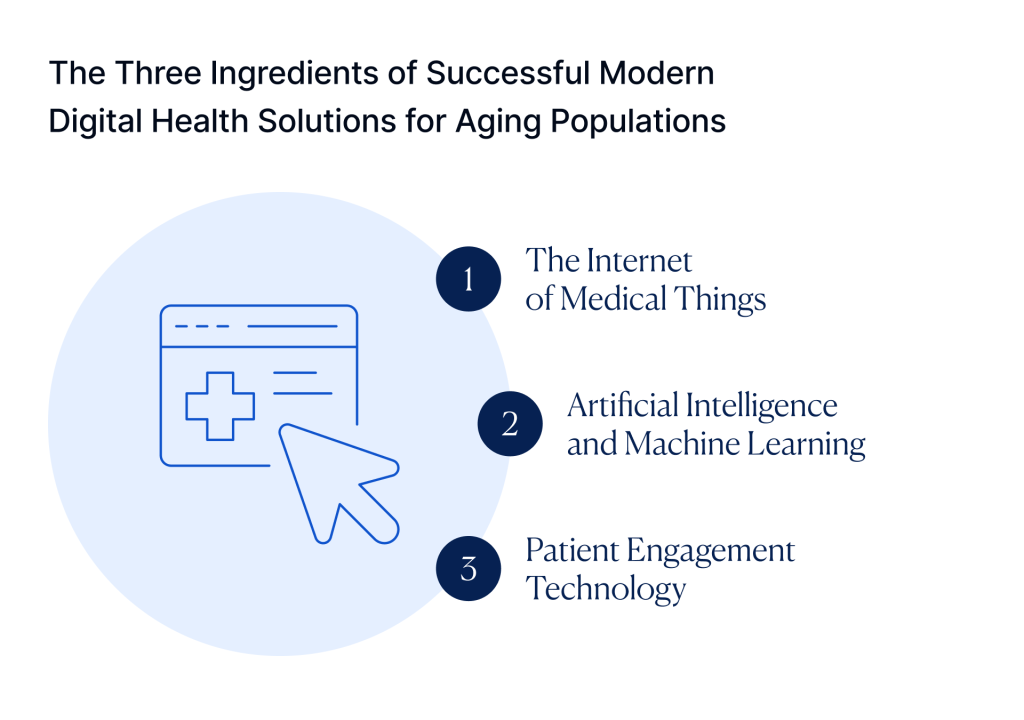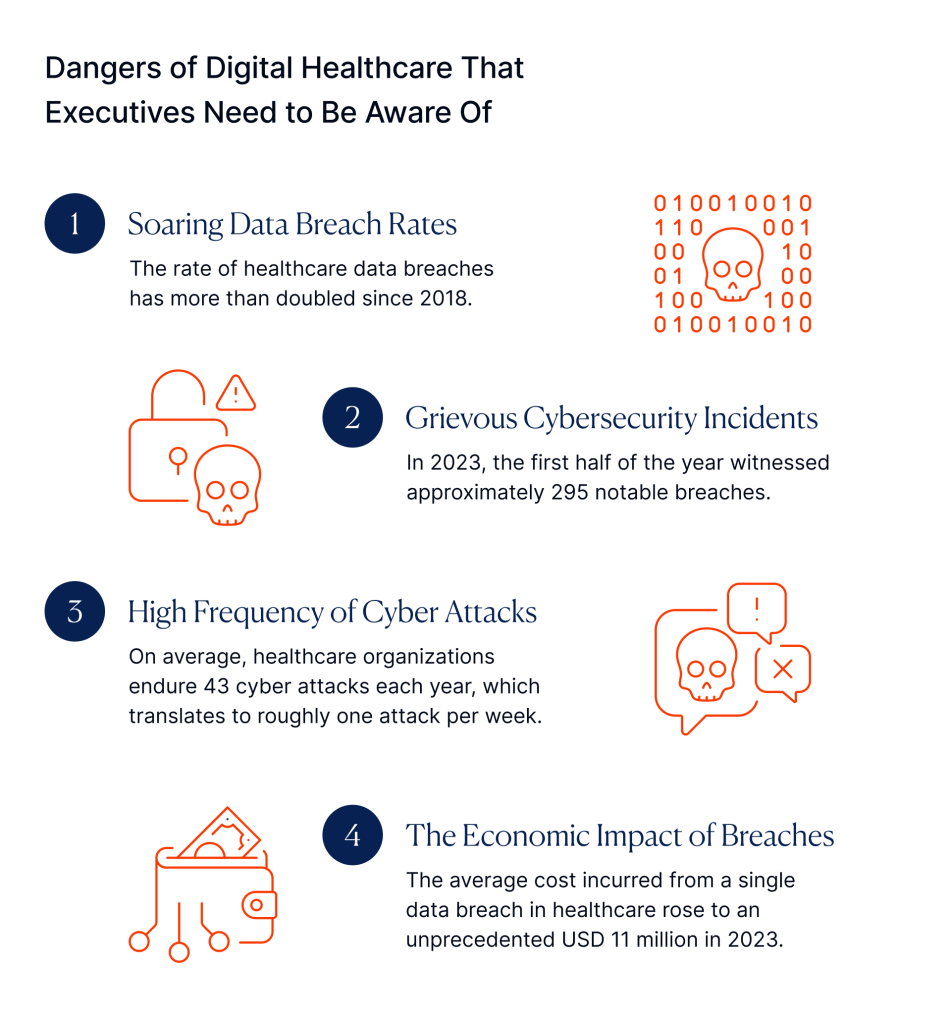
The “silver tsunami” is upon us. By 2050, the world’s population aged 60 years and older is expected to total 2 billion, up from 900 million in 2015, according to the World Health Organization.
That’s a lot of wisdom coming our way, but it also means our healthcare systems are about to be tested like never before.
Mind the (Tech) Gap
While the younger generations are broadcasting their lives on TikTok and making use of AI as a recreational tool, don’t be fooled—more and more seniors are getting tech-savvy by the minute, too.
A report by the Pew Research Center highlighted that four-in-ten seniors now own smartphones, more than double the share that did in 2013. That means that there has never been a better time for healthcare providers to introduce digital health solutions to this population segment.
Today’s seniors are more in tune with technology than ever before, and more likely to appreciate modern solutions to age-old problems.

A Real-World Example of Digital Health in Action
Let’s take a moment to look at a real-world example. Imagine a 78-year-old gentleman named Bob. Bob has hypertension and getting to the clinic for his regular check-ups is a drag. But that’s where digital health tech can save the day.
Bob now has a wearable blood pressure cuff that syncs with his smartphone. He’s sending those data points straight to his doctor. Bob keeps an eye on his health and his doctor stays in the loop. That’s what we call a win-win!
Digital Health Technologies Are an Amalgamation of Existing Solutions
Digital health technology is a broad term that encompasses everything from wearables to implantable devices and the software that connects them. But these devices require additional technology to function at their best.
Digital health technologies need to either tap into the Internet of Medical Things, be AI-enabled, or ideally do both. Incorporating patient engagement technology is also important while harnessing all this potential.

The Internet of Medical Things
The Internet of Medical Things (IoMT) is just a term for the software that connects Bob’s blood pressure cuff to the world of healthcare technology. The network of devices created by this connection not only helps Bob keep tabs on his blood pressure, but also keeps his doctor in the loop in real-time and offers the same opportunities for seniors around the world.
That’s why forecasts from the analysts at Grand View Research suggest that the IoMT market could balloon to nearly USD 170 billion by 2030.
The Age of AI and Machine Learning in Digital Health
Let’s shift gears and talk artificial intelligence (AI) and machine learning for a moment, because here’s where it gets really interesting. AI-powered predictive analytics can foretell when a patient might take a turn for the worse, and machine learning algorithms sift through mountains of data to help fine-tune treatment plans. In the hands of healthcare professionals, AI and machine learning can be lifesaving (both for the patients themselves and for the healthcare provider’s business).
Take, for instance, an AI program developed by a team from Boston Children’s Hospital and Yonsei University that was designed to predict which patients would fail to show up for their appointments. With a hunch derived from data, including local weather data, they were able to double-up bookings and reduce idle clinic time. The no-shows didn’t mess with the schedule because, like magic, there was always a backup patient ready to slip into the slot. And the AI proved to be right 83% of the time.
In Bob’s case, predictive AI might be able to tell him and his healthcare provider when he is most at risk of experiencing spikes in his blood pressure, and when he does, the Internet of Medical Things will notify his doctor and dispatch emergency medical services if needed.
What’s important here is understanding that AI, machine learning, and the connection created through the Internet of Medical Things aren’t replacing the human touch; they’re improving it. They free up valuable time, so healthcare professionals can do what they do best—care for patients with the kind of empathy and understanding that no robot has.

Patient Engagement Technology
You know it’s not just about having digital health tools. It’s also about how they are used. User engagement is the heart of any digital health initiative. There’s a term for this: patient engagement technology. It’s where technology meets the human element of healthcare.
Tools like patient portals, which allow individuals to check on their health information online, are vital. But it’s the user experience that dictates if these portals are just digital paperweights or dynamic windows into a patient’s health.
So, if we’re going for that dynamic window, we’ve got to ensure it’s crystal clear, user-friendly, and, dare I say, even a little fun. A study featured in the Journal of the American Medical Informatics Association outlined that the simplicity and perceived usefulness of health information technology significantly affect seniors’ acceptance and usage.
What Executives Need to Know About the Dangers of Digital Health Transformation
Digital health solutions have the potential to catapult your healthcare business to new heights, but every rose has a thorn. And digital health’s thorn is cybersecurity.
Let’s talk numbers because nothing spells ‘reality check’ like cold hard stats. The rate at which healthcare data breaches are mushrooming is the stuff of nightmares. Back in 2018, there was a healthcare breach of 500 records or more about once a day in the US. Fast-forward to today, and we’ve skipped merrily past ‘concerning’ straight into ‘code red’ territory with rates more than doubling.
And in 2023, we witnessed perhaps the greatest healthcare cybersecurity disaster yet with about 295 notable breaches in the first half of the year alone. Anthem’s data breach comes to mind when citing this statistic, with 78 million records affected.
With each breach, there’s more than just numbers; there are individuals like Bob, whose personal health stories are splashed across the internet without their consent.
That’s why the healthcare cybersecurity scene is not for the faint of heart. We’ve seen 89% of healthcare organizations report an average of 43 cyber-attacks per year—that’s nearly one attack each week.
It’s not just the breaches themselves that sting, but the bills that follow. The average cost of a healthcare data breach in 2023 spiraled up to USD 11 million, marking an 8% increase from the year before and a bone-chilling 53% jump since 2020.
But it’s not all doom and gloom. By beefing up your cybersecurity measures like we recommended in a previous article (linked here), you can protect your patient data. More than half of organizations are nudging their security budgets upwards and 83% of corporate boards advise beefing up IT security personnel. Be part of that smart crowd.
Here’s the main takeaway: put your dollars where your data is. Investing in cybersecurity isn’t a choice—it’s a necessity. And it’s urgent. Because when it comes to the health of your cybersecurity, an ounce of prevention is worth a pound of cure—or in this case, about USD 11 million.

How Executives Can Implement Digital Health Solutions in Their Organizations
Now let’s dig into the nitty-gritty. It’s all well and good to have these technologies available (and to make them safe through cybersecurity investments), but real success comes from implementing these digital health strategies effectively.
Strategy 1: The Human Touch in Tech Support
Just as you wouldn’t throw someone into the deep end without a life jacket, you can’t expect seniors to dive into digital health without support. So, solid tech support is the life jacket here. This might mean 24/7 hotlines or video tutorials that explain how to use e-health tools. Having real human beings ready to assist can turn a frustrating experience into a reassuring one.
Strategy 2: Inclusive Design
Ever seen a “one size fits all” tag and thought, “Yeah, right”? Well, the same skepticism applies to digital health solutions. These need to be designed with the aging population in mind—larger fonts, intuitive interfaces, you get the drift. And here’s a catchy term for you: gerontechnology, the study that combines gerontology and technology to ensure products cater effectively to the needs of the elderly.
Strategy 3: Interoperability
In tech terms, interoperability is like making sure everyone at the table speaks the same language. Health technologies must communicate with each other, so that Bob’s blood pressure cuff can get its message through to his doctor’s scheduling database and the EMT’s dispatch number—after all, nothing’s more frustrating than a broken telephone (or a disconnected tech system).
Strategy 4: Personalized Care Plans
Personalization is king. Or, in healthcare terms, the right prescription. Developing digital care plans designed to meet individual needs is like having a well-tailored suit; it just fits better, and it’s more comfortable for everyone involved. Personalized digital health plans leverage the data collected through various digital health tools to fine-tune care and lead to better patient outcomes. If your digital health tech isn’t personalized, it’s not doing its job.
Final Thoughts for the Future-Forward Healthcare Executive
We’ve established that integrating digital health technology into the care of aging populations isn’t just a passing trend; it’s a must-have for any modern healthcare provider. But where do you go from here?
Consider creating a task force or a digital health innovation lab within your organization. This research and development team can keep the digital health pulse of your organization while ensuring you stay ahead of the curve (and the competition). They should be tasked with keeping abreast of new technologies, regulations, and patient preferences, as well as piloting and innovating new initiatives that can benefit your aging patients.
And when it comes to rollout, think like a Silicon Valley start-up: agile and receptive to feedback. Implement in phases, evaluate, and iterate. The aim of the game here is continuous improvement, not set-and-forget solutions.

At Stanton Chase, we’ve been helping leading healthcare and life sciences companies to find executives and leaders who can drive innovation for more than 30 years. We can help you to position yourself in the digital health ecosystem. Click here to reach out to one of our consultants.
About the Author
Gavin McCartney, a Partner at Stanton Chase London, serves as the Global Sector Leader for the Health and MedTech sector. He brings extensive experience managing executive search assignments for clients at global, regional, and local levels, conducting searches across Europe, US, Africa, the Middle East, and Latin America.
Gavin’s international executive search expertise includes working with multicultural teams in the life sciences and healthcare industry. He handles mandates ranging from C-suite to VP and director positions across various functional areas. Furthermore, complementary to mature global MedTech organizations, Gavin’s experience extends to supporting early to commercialized-stage start-ups and SMEs, navigating the unique challenges of small, fast-growing, and investor-backed organizations.
How Can We Help?
At Stanton Chase, we're more than just an executive search and leadership consulting firm. We're your partner in leadership.
Our approach is different. We believe in customized and personal executive search, executive assessment, board services, succession planning, and leadership onboarding support.
We believe in your potential to achieve greatness and we'll do everything we can to help you get there.
View All Services
